Abstract
OBJECTIVE: To determine the safety and efficacy of recombinant human growth hormone (rhGH) in the treatment of children who are severely burned. SUMMARY BACKGROUND DATA: During the last decade, we have used recombinant human growth hormone (rhGH; 0.2 mg/kg/day s.q.) to successfully treat 130 children with more than 40% total body surface area (TBSA) burns to enhance wound healing and decrease protein loss. A significant increase in the mortality of adult patients in the intensive care unit who were given rhGH has recently been reported in two large European trials which questions the therapeutic safety of rhGH. METHODS: The records of 263 children who were burned were reviewed. Patients receiving either rhGH at 0.2 mg/kg/day subcutaneously as part of a randomized clinical trial (n = 48) or therapeutically (n = 82) were compared with randomized placebo-administered controls (n = 54), contiguous matched controls (n = 48), and matched patients admitted after August 1997, after which no patients were treated with rhGH (n = 31). Morbidity and mortality, which might be altered by rhGH therapy, were considered with specific attention to organ function or failure, infection, hemodynamics, and calcium, phosphorous, and albumin balance. RESULTS: A 2% mortality was observed in both rhGH and saline placebo groups in the controlled studies, with no differences in septic complications, organ dysfunction, or heart rate pressure product identified. In addition, no difference in mortality could be shown for those given rhGH therapeutically versus their controls. No patient deaths were attributed to rhGH in autopsies reviewed by observers blinded to treatment. Hyperglycemic episodes and exogenous insulin requirements were higher among rhGH recipients, whereas exogenous albumin requirements and the development of hypocalcemia was reduced. CONCLUSIONS: Data indicate that rhGH used in the treatment of children who were severely burned is safe and efficacious.
Full text
PDF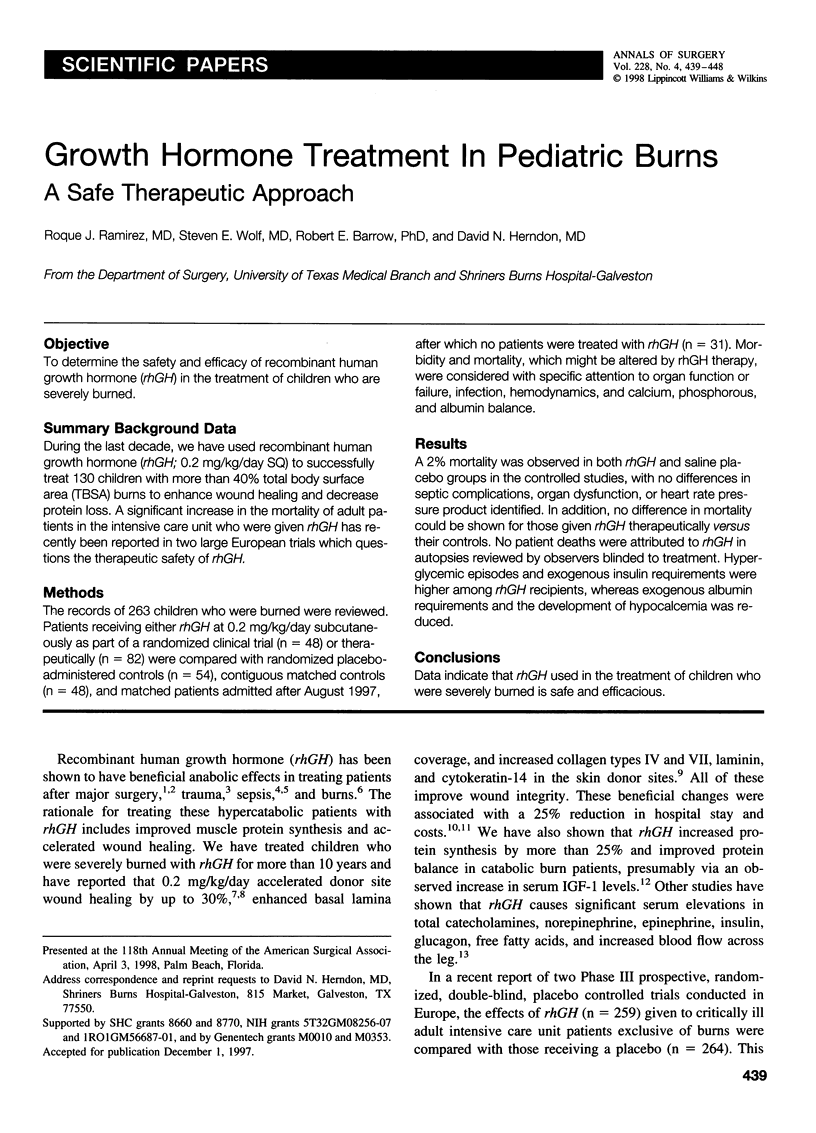
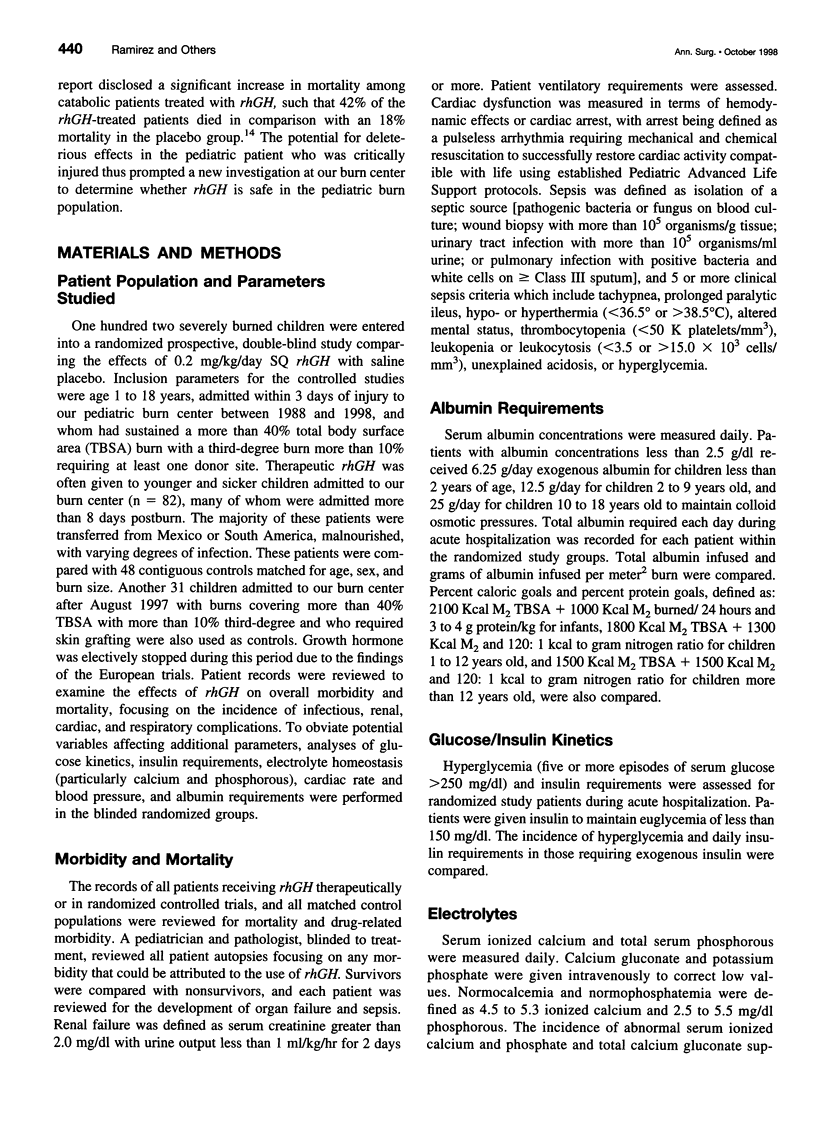
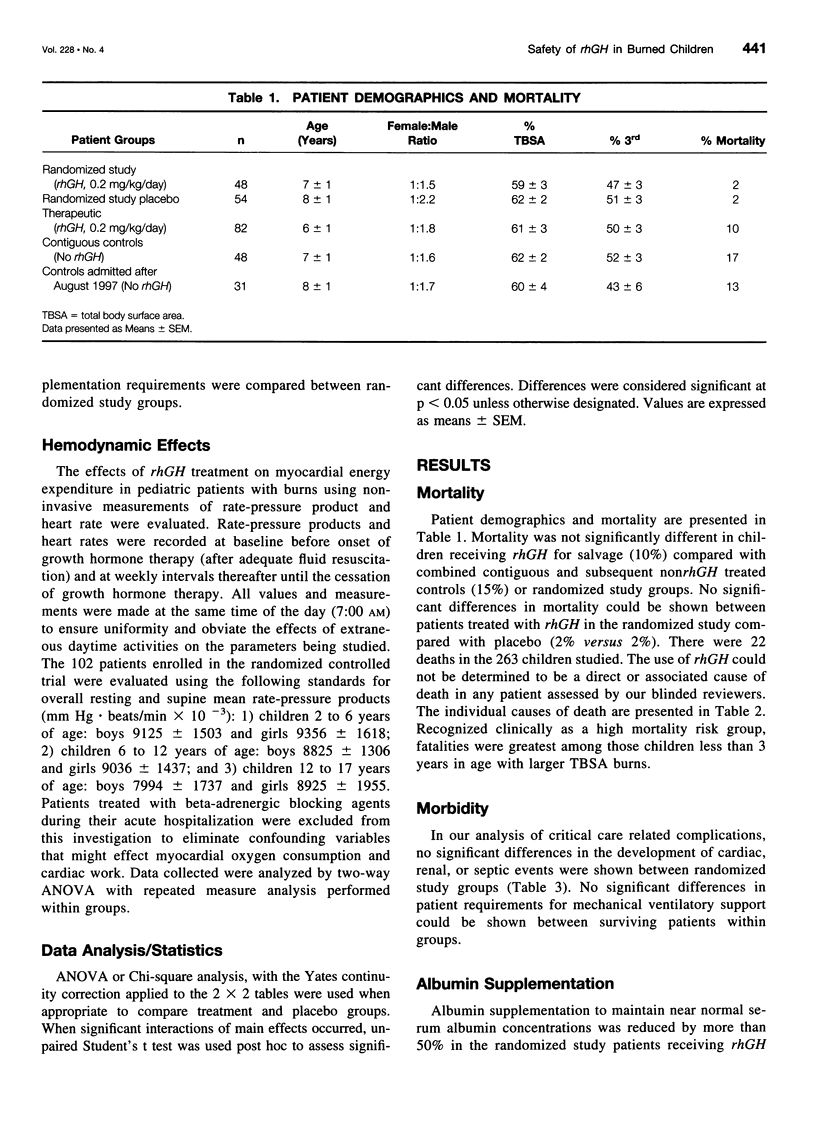
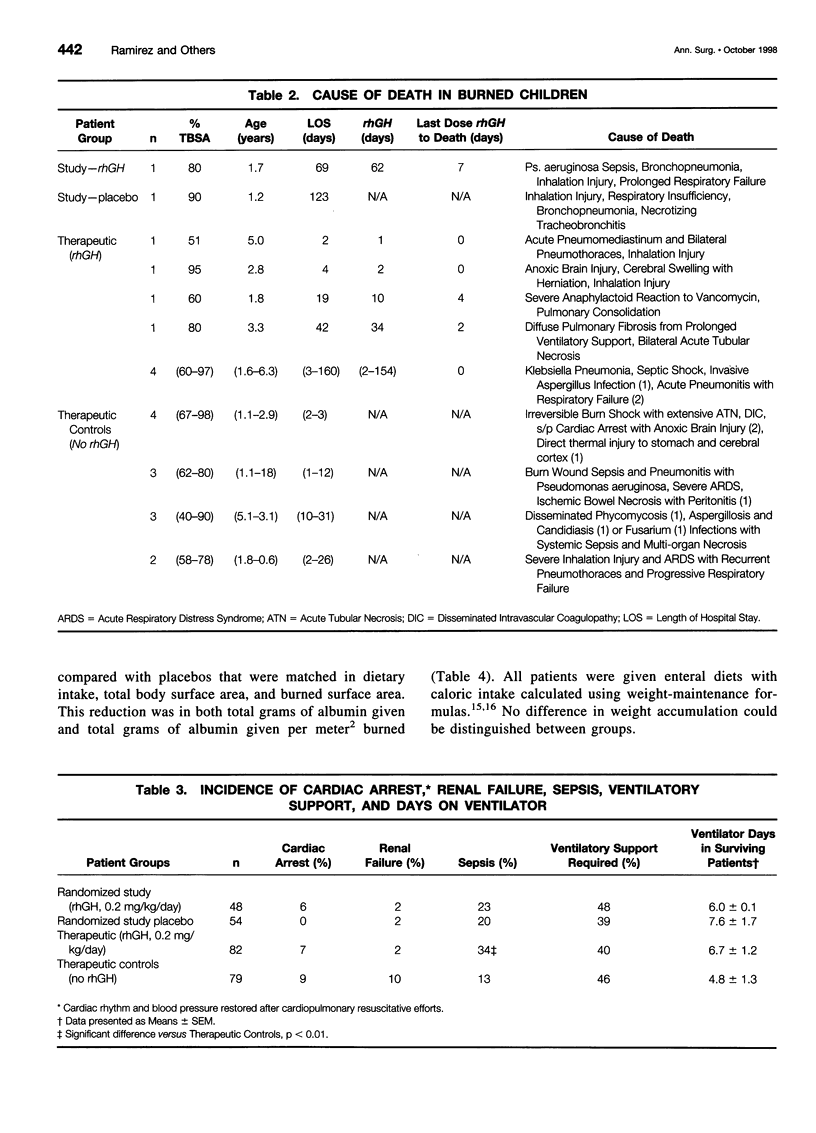
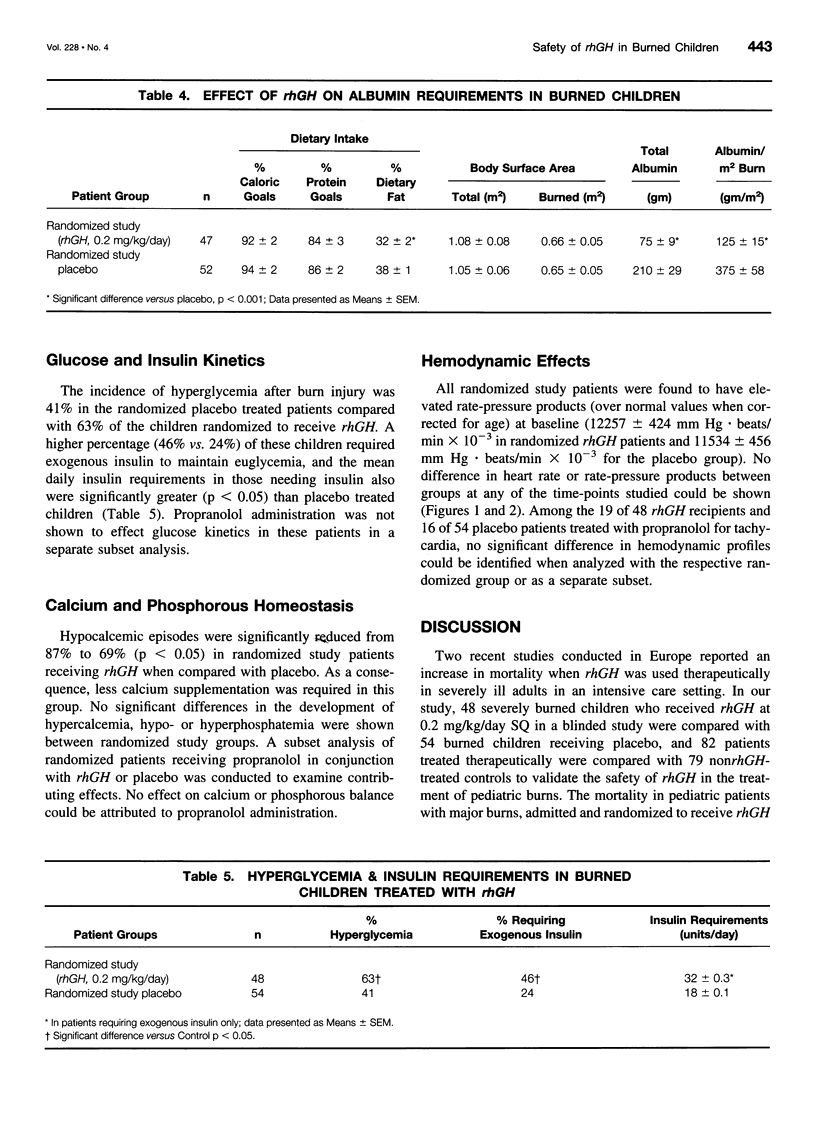
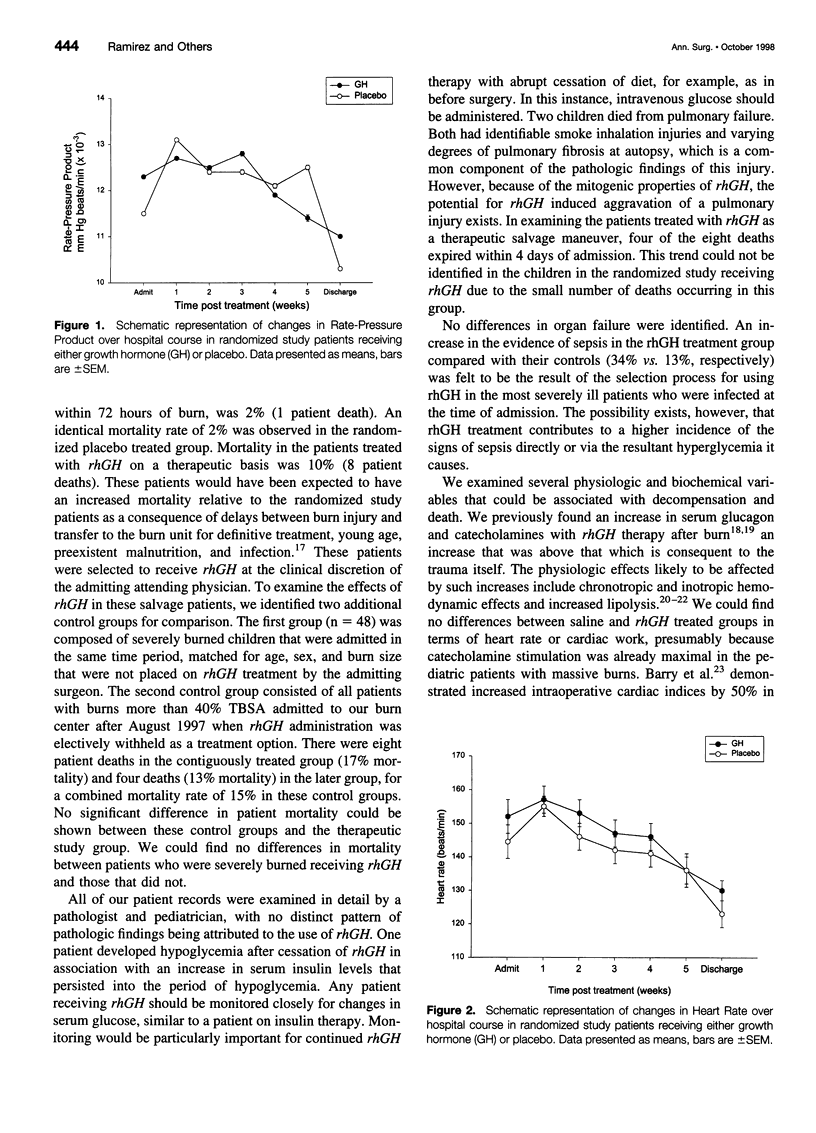
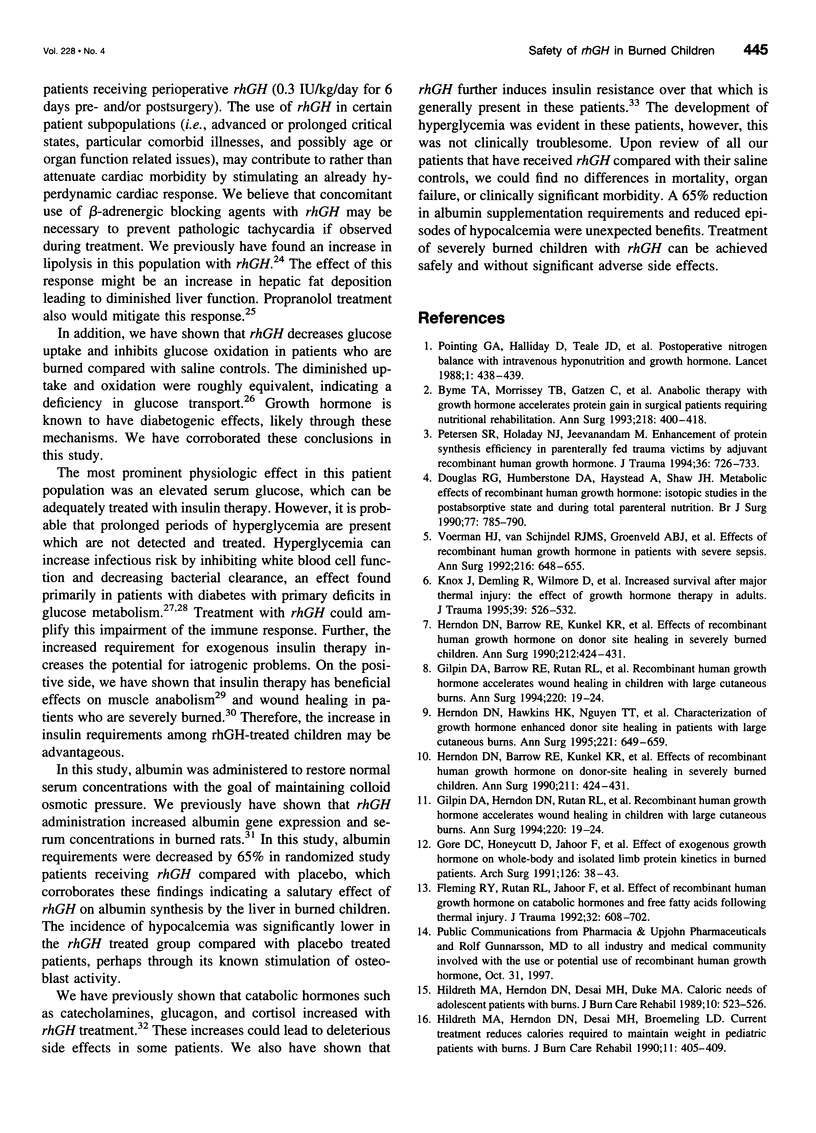
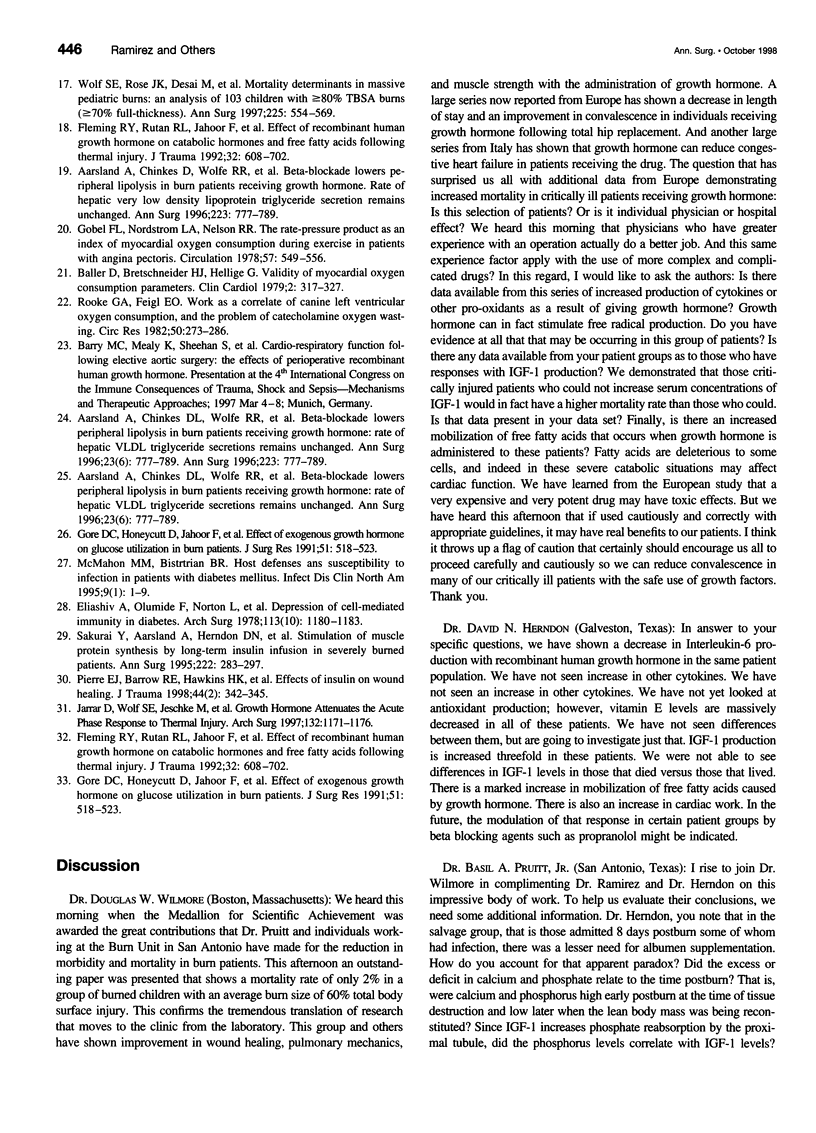
Selected References
These references are in PubMed. This may not be the complete list of references from this article.
- Aarsland A., Chinkes D., Wolfe R. R., Barrow R. E., Nelson S. O., Pierre E., Herndon D. N. Beta-blockade lowers peripheral lipolysis in burn patients receiving growth hormone. Rate of hepatic very low density lipoprotein triglyceride secretion remains unchanged. Ann Surg. 1996 Jun;223(6):777–789. doi: 10.1097/00000658-199606000-00016. [DOI] [PMC free article] [PubMed] [Google Scholar]
- Aarsland A., Chinkes D., Wolfe R. R., Barrow R. E., Nelson S. O., Pierre E., Herndon D. N. Beta-blockade lowers peripheral lipolysis in burn patients receiving growth hormone. Rate of hepatic very low density lipoprotein triglyceride secretion remains unchanged. Ann Surg. 1996 Jun;223(6):777–789. doi: 10.1097/00000658-199606000-00016. [DOI] [PMC free article] [PubMed] [Google Scholar]
- Baller D., Bretschneider H. J., Hellige G. Validity of myocardial oxygen consumption parameters. Clin Cardiol. 1979 Oct;2(5):317–327. doi: 10.1002/clc.4960020502. [DOI] [PubMed] [Google Scholar]
- Byrne T. A., Morrissey T. B., Gatzen C., Benfell K., Nattakom T. V., Scheltinga M. R., LeBoff M. S., Ziegler T. R., Wilmore D. W. Anabolic therapy with growth hormone accelerates protein gain in surgical patients requiring nutritional rehabilitation. Ann Surg. 1993 Oct;218(4):400–418. doi: 10.1097/00000658-199310000-00002. [DOI] [PMC free article] [PubMed] [Google Scholar]
- Douglas R. G., Humberstone D. A., Haystead A., Shaw J. H. Metabolic effects of recombinant human growth hormone: isotopic studies in the postabsorptive state and during total parenteral nutrition. Br J Surg. 1990 Jul;77(7):785–790. doi: 10.1002/bjs.1800770722. [DOI] [PubMed] [Google Scholar]
- Eliashiv A., Olumide F., Norton L., Eiseman B. Depression of cell-mediated immunity in diabetes. Arch Surg. 1978 Oct;113(10):1180–1183. doi: 10.1001/archsurg.1978.01370220066011. [DOI] [PubMed] [Google Scholar]
- Gilpin D. A., Barrow R. E., Rutan R. L., Broemeling L., Herndon D. N. Recombinant human growth hormone accelerates wound healing in children with large cutaneous burns. Ann Surg. 1994 Jul;220(1):19–24. doi: 10.1097/00000658-199407000-00004. [DOI] [PMC free article] [PubMed] [Google Scholar]
- Gilpin D. A., Barrow R. E., Rutan R. L., Broemeling L., Herndon D. N. Recombinant human growth hormone accelerates wound healing in children with large cutaneous burns. Ann Surg. 1994 Jul;220(1):19–24. doi: 10.1097/00000658-199407000-00004. [DOI] [PMC free article] [PubMed] [Google Scholar]
- Gobel F. L., Norstrom L. A., Nelson R. R., Jorgensen C. R., Wang Y. The rate-pressure product as an index of myocardial oxygen consumption during exercise in patients with angina pectoris. Circulation. 1978 Mar;57(3):549–556. doi: 10.1161/01.cir.57.3.549. [DOI] [PubMed] [Google Scholar]
- Gore D. C., Honeycutt D., Jahoor F., Rutan T., Wolfe R. R., Herndon D. N. Effect of exogenous growth hormone on glucose utilization in burn patients. J Surg Res. 1991 Dec;51(6):518–523. doi: 10.1016/0022-4804(91)90175-l. [DOI] [PubMed] [Google Scholar]
- Gore D. C., Honeycutt D., Jahoor F., Rutan T., Wolfe R. R., Herndon D. N. Effect of exogenous growth hormone on glucose utilization in burn patients. J Surg Res. 1991 Dec;51(6):518–523. doi: 10.1016/0022-4804(91)90175-l. [DOI] [PubMed] [Google Scholar]
- Gore D. C., Honeycutt D., Jahoor F., Wolfe R. R., Herndon D. N. Effect of exogenous growth hormone on whole-body and isolated-limb protein kinetics in burned patients. Arch Surg. 1991 Jan;126(1):38–43. doi: 10.1001/archsurg.1991.01410250042006. [DOI] [PubMed] [Google Scholar]
- Herndon D. N., Barrow R. E., Kunkel K. R., Broemeling L., Rutan R. L. Effects of recombinant human growth hormone on donor-site healing in severely burned children. Ann Surg. 1990 Oct;212(4):424–431. doi: 10.1097/00000658-199010000-00005. [DOI] [PMC free article] [PubMed] [Google Scholar]
- Herndon D. N., Barrow R. E., Kunkel K. R., Broemeling L., Rutan R. L. Effects of recombinant human growth hormone on donor-site healing in severely burned children. Ann Surg. 1990 Oct;212(4):424–431. doi: 10.1097/00000658-199010000-00005. [DOI] [PMC free article] [PubMed] [Google Scholar]
- Herndon D. N., Hawkins H. K., Nguyen T. T., Pierre E., Cox R., Barrow R. E. Characterization of growth hormone enhanced donor site healing in patients with large cutaneous burns. Ann Surg. 1995 Jun;221(6):649–659. doi: 10.1097/00000658-199506000-00004. [DOI] [PMC free article] [PubMed] [Google Scholar]
- Hildreth M. A., Herndon D. N., Desai M. H., Broemeling L. D. Current treatment reduces calories required to maintain weight in pediatric patients with burns. J Burn Care Rehabil. 1990 Sep-Oct;11(5):405–409. doi: 10.1097/00004630-199009000-00006. [DOI] [PubMed] [Google Scholar]
- Hildreth M. A., Herndon D. N., Desai M. H., Duke M. A. Caloric needs of adolescent patients with burns. J Burn Care Rehabil. 1989 Nov-Dec;10(6):523–526. doi: 10.1097/00004630-198911000-00012. [DOI] [PubMed] [Google Scholar]
- Jarrar D., Wolf S. E., Jeschke M. G., Ramirez R. J., DebRoy M., Ogle C. K., Papaconstaninou J., Herndon D. N. Growth hormone attenuates the acute-phase response to thermal injury. Arch Surg. 1997 Nov;132(11):1171–1176. doi: 10.1001/archsurg.1997.01430350021003. [DOI] [PubMed] [Google Scholar]
- Kearney T. J., Bentt L., Grode M., Lee S., Hiatt J. R., Shabot M. M. Coagulopathy and catecholamines in severe head injury. J Trauma. 1992 May;32(5):608–612. doi: 10.1097/00005373-199205000-00012. [DOI] [PubMed] [Google Scholar]
- Kearney T. J., Bentt L., Grode M., Lee S., Hiatt J. R., Shabot M. M. Coagulopathy and catecholamines in severe head injury. J Trauma. 1992 May;32(5):608–612. doi: 10.1097/00005373-199205000-00012. [DOI] [PubMed] [Google Scholar]
- Kearney T. J., Bentt L., Grode M., Lee S., Hiatt J. R., Shabot M. M. Coagulopathy and catecholamines in severe head injury. J Trauma. 1992 May;32(5):608–612. doi: 10.1097/00005373-199205000-00012. [DOI] [PubMed] [Google Scholar]
- Knox J., Demling R., Wilmore D., Sarraf P., Santos A. Increased survival after major thermal injury: the effect of growth hormone therapy in adults. J Trauma. 1995 Sep;39(3):526–532. doi: 10.1097/00005373-199509000-00021. [DOI] [PubMed] [Google Scholar]
- McMahon M. M., Bistrian B. R. Host defenses and susceptibility to infection in patients with diabetes mellitus. Infect Dis Clin North Am. 1995 Mar;9(1):1–9. [PubMed] [Google Scholar]
- Petersen S. R., Holaday N. J., Jeevanandam M. Enhancement of protein synthesis efficiency in parenterally fed trauma victims by adjuvant recombinant human growth hormone. J Trauma. 1994 May;36(5):726–733. doi: 10.1097/00005373-199405000-00022. [DOI] [PubMed] [Google Scholar]
- Pierre E. J., Barrow R. E., Hawkins H. K., Nguyen T. T., Sakurai Y., Desai M., Wolfe R. R., Herndon D. N. Effects of insulin on wound healing. J Trauma. 1998 Feb;44(2):342–345. doi: 10.1097/00005373-199802000-00019. [DOI] [PubMed] [Google Scholar]
- Ponting G. A., Halliday D., Teale J. D., Sim A. J. Postoperative positive nitrogen balance with intravenous hyponutrition and growth hormone. Lancet. 1988 Feb 27;1(8583):438–440. doi: 10.1016/s0140-6736(88)91232-9. [DOI] [PubMed] [Google Scholar]
- Rooke G. A., Feigl E. O. Work as a correlate of canine left ventricular oxygen consumption, and the problem of catecholamine oxygen wasting. Circ Res. 1982 Feb;50(2):273–286. doi: 10.1161/01.res.50.2.273. [DOI] [PubMed] [Google Scholar]
- Sakurai Y., Aarsland A., Herndon D. N., Chinkes D. L., Pierre E., Nguyen T. T., Patterson B. W., Wolfe R. R. Stimulation of muscle protein synthesis by long-term insulin infusion in severely burned patients. Ann Surg. 1995 Sep;222(3):283–297. doi: 10.1097/00000658-199509000-00007. [DOI] [PMC free article] [PubMed] [Google Scholar]
- Voerman H. J., van Schijndel R. J., Groeneveld A. B., de Boer H., Nauta J. P., van der Veen E. A., Thijs L. G. Effects of recombinant human growth hormone in patients with severe sepsis. Ann Surg. 1992 Dec;216(6):648–655. doi: 10.1097/00000658-199212000-00006. [DOI] [PMC free article] [PubMed] [Google Scholar]
- Wolf S. E., Rose J. K., Desai M. H., Mileski J. P., Barrow R. E., Herndon D. N. Mortality determinants in massive pediatric burns. An analysis of 103 children with > or = 80% TBSA burns (> or = 70% full-thickness). Ann Surg. 1997 May;225(5):554–569. doi: 10.1097/00000658-199705000-00012. [DOI] [PMC free article] [PubMed] [Google Scholar]


